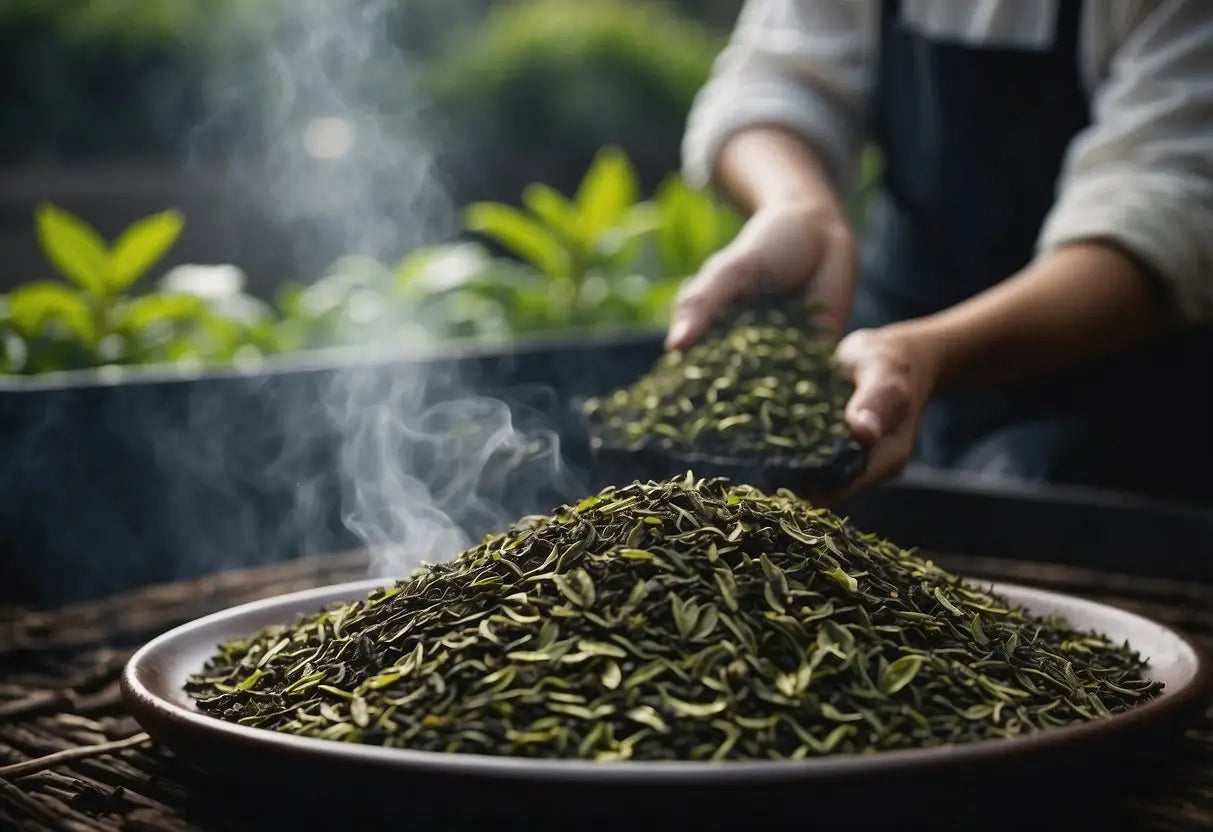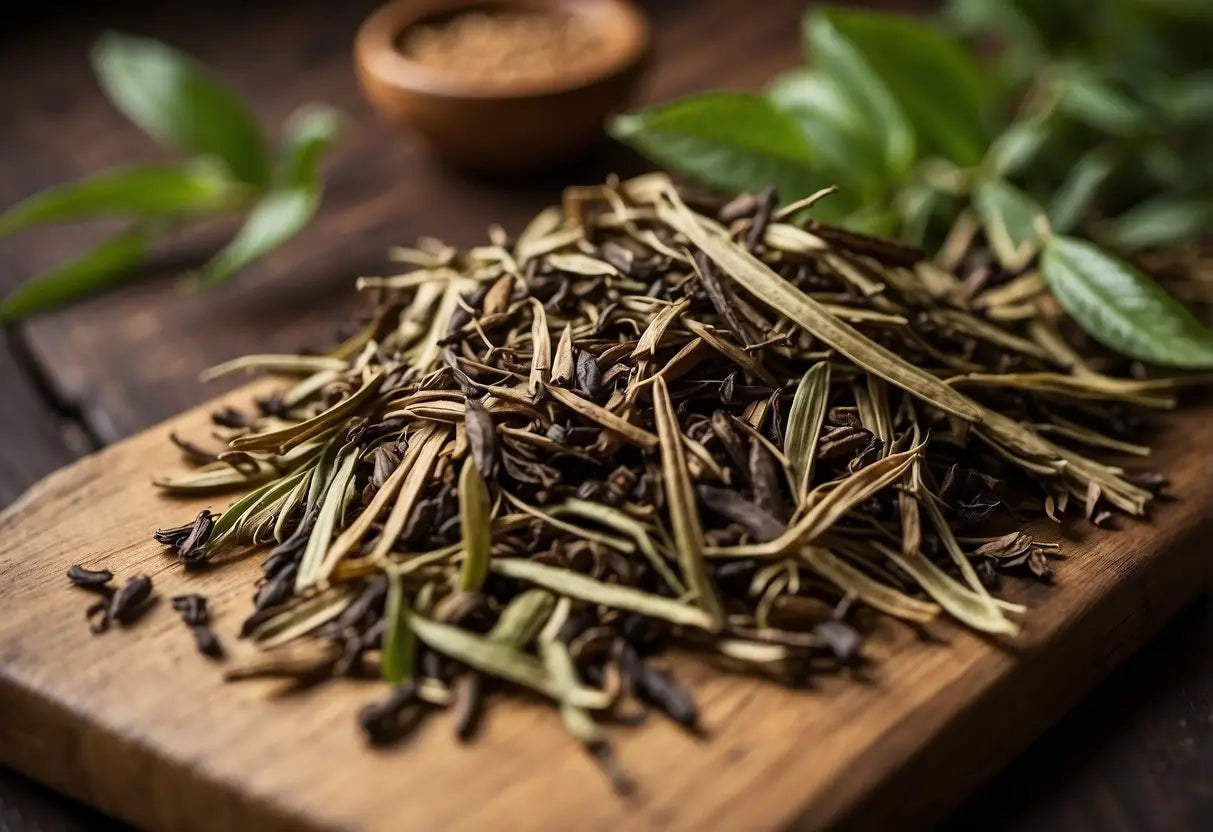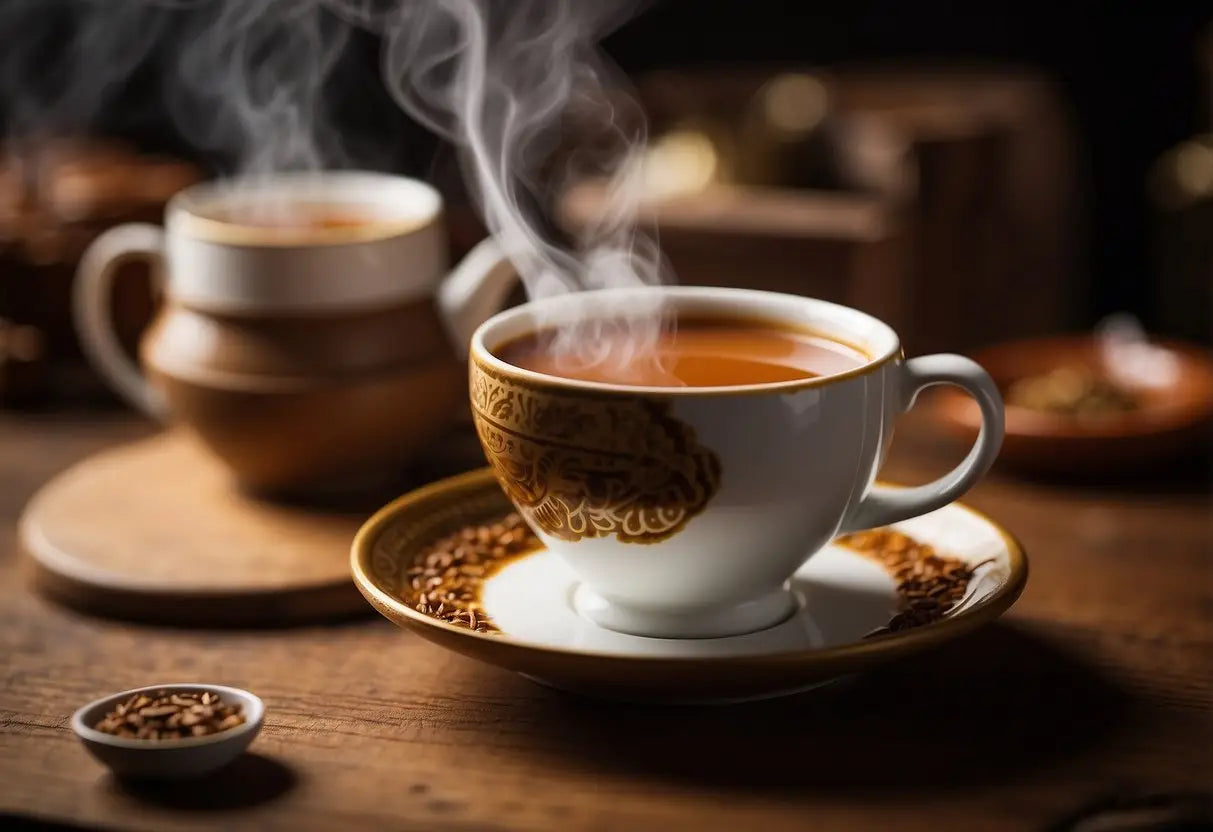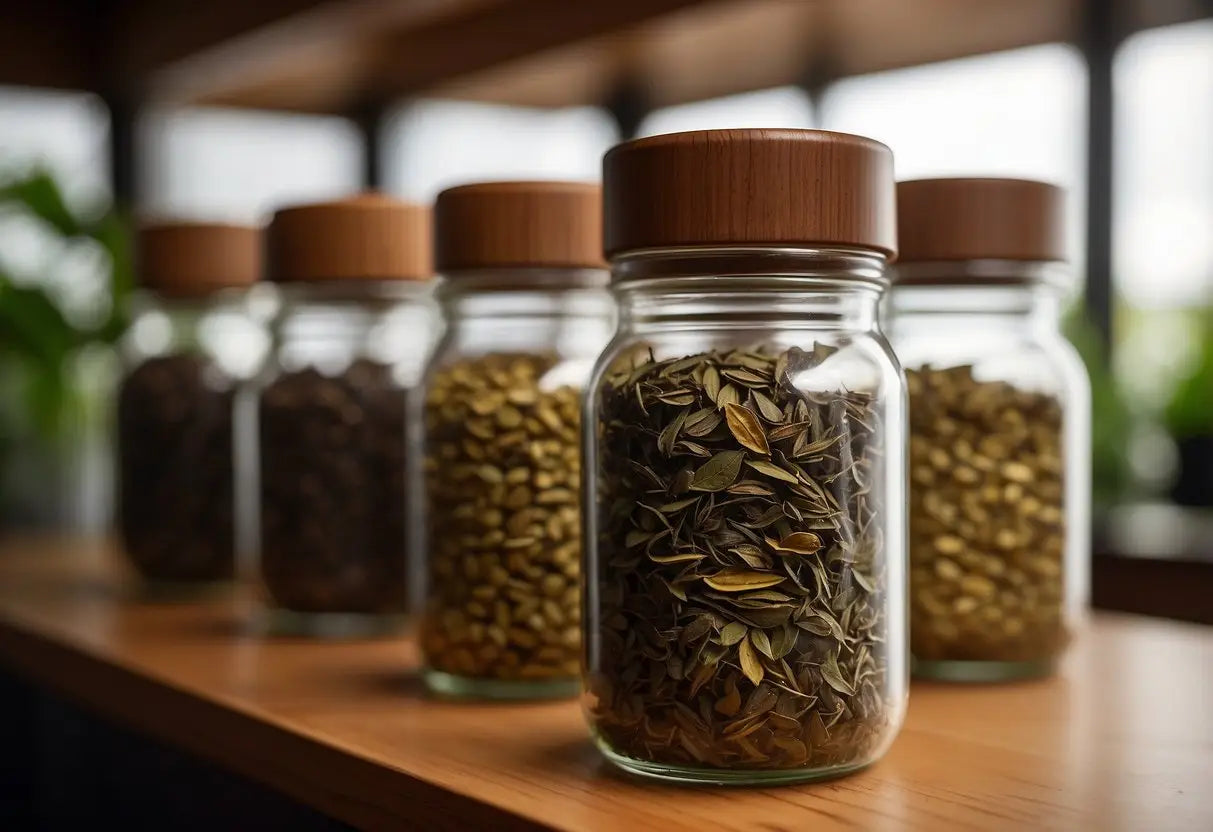What Is Hojicha
Hojicha is a roasted green tea with a unique flavor profile and rich cultural history. It offers a distinct departure from traditional green teas by providing a smooth, nutty taste.
Definition and Characteristics
Hojicha is made from roasted green tea leaves, stems, or twigs. The roasting process gives it a reddish-brown color and reduces its caffeine content. Unlike other green teas, it has a toasty and caramel-like flavor with lower astringency. Its aroma is often described as warm and inviting.
Key Characteristics:
Bestsellers
- Color: Reddish-brown
- Flavor: Nutty, toasty, and slightly sweet
- Caffeine: Lower compared to other green teas
- Aroma: Warm and earthy
Origin and History
Hojicha originated in Japan in the 1920s. The technique of roasting green tea leaves was developed in Kyoto. Initially, it was made from bancha or mature tea leaves, but today, various grades can be used. Its creation was a way to use leftover leaves, making it both economical and appealing due to its unique taste.
Notable Points:
- First Developed: 1920s, Kyoto
- Initial Purpose: Economical use of leftover leaves
- Cultural Significance: Popular in Japanese households and widely enjoyed both hot and cold
Production Process

Hojicha is distinct due to its unique production steps. The key stages include harvesting the tea leaves, roasting them to enhance flavor and aroma, and grinding if making powdered hojicha.
Harvesting
Tea leaves for hojicha are typically harvested later in the season. This results in more mature leaves with lower caffeine content. Usually, the second or third flush of leaves is used. These leaves are larger and have a coarser texture, making them ideal for roasting.
The leaves are carefully selected and plucked by hand. This careful selection ensures only the best leaves are chosen, vital for the high-quality taste of hojicha. Once harvested, the leaves are immediately steamed to preserve their green color and to prevent oxidation.
Roasting
Roasting is the most crucial step in the production of hojicha. The steamed tea leaves are placed in a roasting pan and heated at approximately 200°C (392°F). This process reduces bitterness and imparts a unique smoky, nutty flavor.
The leaves change color from green to reddish-brown during roasting. This color change is an important indicator of the richness and depth of the tea's flavor. The roasting process also affects the tea's aroma, giving it a distinct toasty scent.
Grinding
While hojicha is often enjoyed as loose leaves, it can also be ground into a fine powder. This powdered form can be used for making hojicha lattes or adding a roasted flavor to various desserts.
To grind hojicha, the roasted leaves are run through a stone mill. This requires precise, careful work to ensure a consistent texture. The resulting powder retains the roasted aroma and flavor, making it versatile for culinary uses beyond just brewing tea.
Types of Hojicha

Hojicha comes in various forms, each with different characteristics and uses. Understanding these types helps in choosing the right one for your needs.
Lao Ban Zhang
Hojicha Leaves
Hojicha leaves are the most traditional form of this tea. Roasted more intensely than standard green tea, they have a darker color and a nutty, slightly sweet flavor.
The leaves are typically sourced from mature tea plants, which enhances their robust taste. Commonly brewed in teapots, this form is ideal for enjoying the full, rich aroma of Hojicha.
Brew Tip: Use water that's not boiling, around 80°C (176°F), to prevent bitterness.
Hojicha Powder
Hojicha powder offers a versatile and convenient way to enjoy this tea. Finely ground from roasted leaves, it blends easily into various recipes such as lattes, smoothies, and desserts.
Usage: Mix the powder directly into hot water or milk. It dissolves quickly, providing a swift and potent flavor profile. You can also use it in baking for a unique, roasted flavor.
Kuki Hojicha
Kuki Hojicha, or stem Hojicha, is made from the roasted stems, stalks, and twigs of the tea plant. This gives it a lighter taste compared to leaf Hojicha, with a slightly woody and sweet undertone.
Its caffeine content is generally lower, making it a great evening tea. The infusion process is similar to leaf Hojicha, but it can steep slightly longer due to the sturdiness of the stems.
Tip: Ideal for those looking for a milder tea with reduced caffeine.
Flavor Profile

Hojicha is known for its unique, roasted flavor and pleasant aroma. It offers a rich experience that sets it apart from other Japanese teas.
Taste Notes
Hojicha's taste is distinct due to the roasting process. You will notice a smooth, toasty flavor with hints of caramel and chocolate. This tea has low bitterness and contains little astringency, making it easy to drink. The roasting process reduces the caffeine content, resulting in a mild yet flavorful cup.
Aroma
The aroma of hojicha is warm and inviting. You will find it has a roasted, nutty scent, reminiscent of autumn leaves. This aroma is often compared to that of roasted chestnuts or barley. The scent alone can be soothing and adds to the overall comforting experience of drinking hojicha.
Brewing Methods
Brewing hojicha involves a range of methods, from traditional Japanese techniques to modern variations. Each approach highlights the unique flavors of this roasted green tea.
Traditional Japanese Brewing
In traditional Japanese brewing, you typically use a small teapot called a kyusu. Start by adding 1-2 teaspoons of loose leaf hojicha to the teapot. Heat water to around 176°F (80°C), avoiding boiling water. Pour the water over the tea leaves and steep for about 30 seconds to 1 minute.
This method brings out the roasted, nutty flavors of hojicha. Use smaller, frequent pours to ensure even extraction. This technique emphasizes the tea's subtle sweetness and complexity without bitterness. A soft, balanced flavor characterizes the result.
Modern Brewing Techniques
For modern brewing, you might use devices like tea infusers or tea bags. This can be convenient for quick preparation. Use a consistent water temperature of around 176°F (80°C), similar to traditional methods. Steep tea bags or infusers for about 1-2 minutes.
This approach simplifies the brewing process while retaining the essence of hojicha. Electric kettles and timers can help maintain precision. Some prefer cold-brewing by steeping the leaves in cold water for 4-6 hours in the fridge, which offers a milder, refreshing taste suitable for warmer climates.
Culinary Uses

Hojicha, with its distinct roasted flavor, finds versatile applications in both traditional Japanese cuisine and innovative Western dishes.
Hojicha in Japanese Cuisine
In Japanese cuisine, hojicha is more than just a beverage. It's often used in soups and broths to impart a subtle smoky flavor. You’ll find hojicha powder as an ingredient in savory dishes like rice porridge (okayu) and chawanmushi (savory egg custard).
Desserts are another area where hojicha shines. Hojicha ice cream, cakes, and pudding are popular due to the tea’s unique taste, which balances the sweetness. Hojicha jelly and yokan (a type of jelly dessert) are other notable mentions. Incorporating hojicha into traditional rice balls (onigiri) adds an unexpected twist.
Hojicha in Western Dishes
In Western cuisine, hojicha has carved out a niche in both sweet and savory preparations. Hojicha lattes and frappes are crowd favorites in cafes. The roasted notes of the tea complement milk-based drinks exceptionally well. You can also use hojicha powder in baked goods like cookies, muffins, and bread, giving them a unique depth of flavor.
For savory dishes, hojicha can be used as a seasoning or marinade, especially for meats and vegetables. Its complex flavor profile enhances sauces and dressings. Hojicha-infused chocolates and truffles are another inventive use, merging traditional tea with modern confectionery techniques.
Storage and Shelf Life

To preserve the quality of your hojicha, store it in an airtight container. This protects the tea from moisture, light, and odors.
Keep the container in a cool, dark place. Avoid exposing it to direct sunlight or strong smells, which can affect the flavor.
- Use opaque containers.
- Avoid refrigerating to prevent moisture.
- Label the container with the purchase date.
Hojicha typically lasts for 6 to 12 months. For the best taste, consume it within six months of opening.
Pay attention to signs of spoilage, such as a stale odor or off-flavors. Proper storage can ensure a longer and more pleasant shelf life for your hojicha.
Cultural Significance

Hojicha has deep roots in Japanese culture and has garnered interest across the globe. Its unique roasting process and flavor profile set it apart from other green teas.
Hojicha in Japan
Hojicha holds a special place in Japanese tea traditions. Originating in Kyoto in the 1920s, it was created as a way to utilize leftover tea leaves, stems, and twigs. The roasting process imparts its characteristic smoky flavor and brownish color.
In Japan, Hojicha is often enjoyed in the evening due to its lower caffeine content compared to other green teas. It is served hot or cold and is particularly popular with families and the elderly. You’ll find it in teahouses, homes, and even traditional Japanese meals as a palate cleanser.
Hojicha is also a common ingredient in Japanese desserts, such as ice cream and mochi, highlighting its versatility and cultural imprint.
Popularity Worldwide
Hojicha's appeal extends far beyond Japan. With rising global interest in Japanese cuisine and culture, Hojicha has made its mark internationally. Cafés and specialty tea shops around the world have started offering Hojicha-based drinks and desserts, introducing its unique flavor to new audiences.
In many countries, you can find Hojicha-flavored lattes, baked goods, and even cocktails. Its lower caffeine level and rich, roasted taste make it an attractive option for those looking to explore different types of tea without the jitteriness often associated with caffeine.
Online retailers and importers have also contributed to its global spread, making Hojicha accessible to a wider audience. Its growing popularity underscores its versatility and the universal appeal of its distinctive flavor.
Purchase and Selection Tips
When purchasing hojicha, prioritize freshness. Look for loose-leaf options stored in airtight containers or sealed bags. Packaging should indicate a recent roasting date.
Consider leaf quality. High-grade hojicha has whole, unbroken leaves. Avoid dusty or fragmented leaves, which often indicate lower quality.
Check the color. Quality hojicha has a deep brown or reddish hue due to its roasting process. Pale or greenish leaves are a sign of improper roasting.
Opt for reputable sellers. Specialty tea shops or online retailers with good reviews usually offer better quality hojicha compared to general grocery stores.
Sample sizes are a useful way to try different types. Many sellers offer smaller packets. This approach helps you find your preferred flavor without committing to a large quantity.
Store your hojicha in a cool, dark place. Heat and light can degrade its quality. Use airtight containers to preserve its roasted aroma.
Price can be an indicator of quality, but not always. Mid-range options often offer a good balance. Be wary of excessively cheap hojicha.
Consider organic options if you’re concerned about pesticides or farming practices. Organic hojicha may cost more but offers added peace of mind.
Check the origin. Many fine hojicha teas come from well-known tea-growing regions in Japan. Familiar names like Kyoto or Shizuoka often signify quality.
← Older post Newer post →











